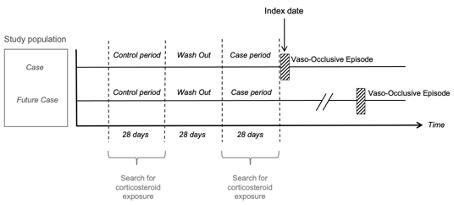Abstract

Introduction : Sickle cell disease (SCD) is an inherited disorder which affects 300,000 newborns per year. Vaso-occlusive episodes (VOEs) cause an important morbi-mortality and a decreased quality of life in patients with SCD. Some risk factors of VOE are well known, like infection, cold exposure, stress, pulmonary diseases and dehydration. Exposure to systemic corticosteroids has been suspected to increase the occurrence of VOEs in few case reports or series. However, no comparative study has been conducted to demonstrate this risk which is still debated, resulting in discrepancies among guidelines on SCD management. This study aimed to assess the risk of hospitalization for VOE associated with out-hospital exposure to systemic corticosteroids in patients with SCD in France.
Methods : Data source was the French national health insurance system database, named SNDS (Système National des Données de Santé) between 2010 and 2018. The SNDS links sociodemographic, out- and in-hospital data for the entire French population (>66 million inhabitants). The study population consisted in all patients with SCD with at least one hospitalization for VOE during the study period, identified with a primary discharge diagnosis of VOE (D57.0 code of the international classification of disease, 10 th version; positive predictive value: 98.6%). All genotypes (homozygous SS-SCD and double-heterozygous SCD) were included. Because we assessed out-hospital exposure to corticosteroids, patients hospitalized during the three months before the first VOE were excluded. We performed a case-case-time-control study (Figure 1). This self-controlled design results in self-adjustment for time-independent confounders, including genotype. The outcome was the first hospitalization for VOE. The exposure to oral and injectable corticosteroids, identified using out-hospital reimbursement data, was assessed during a case period (28 days before the outcome) compared to the exposure during a control period (28 days, starting 84 days before the outcome). The same comparison was made among future cases (matched patients hospitalized for VOE the year after the given case), in order to adjust for the trend of exposure to corticosteroids (calendar variations of corticosteroid exposure).
Results : Overall, 5,151 cases of VOEs were included in the main analysis. Median age at first VOE was 16.9 years; 317 (6.2%) patients were exposed to corticosteroids during the case period. In the main analysis, corticosteroid exposure was significantly associated with the occurrence of hospitalizations for VOEs: adjusted Odds Ratio (aOR): 3.81, 95% confidence interval (95% CI): 2.44 to 5.61. In patients exposed to hydroxyurea, the aOR was 2.61, 95% CI: 1.07 to 6.39, compared with an aOR of 4.00, 95% CI: 2.53 to 6.30 in unexposed patients. In the subgroup analysis by age, the aOR was 2.81, 95% CI: 1.49 to 5.30 in children, and 4.45, 95% CI: 2.37 to 8.37 in adults. The results were consistent in all sensitivity analyses.
Conclusion : This study showed an association between outpatient exposure to systemic corticosteroids with an increased risk of hospitalization for VOE, in both adults and children. Hydroxyurea may reduce this risk in adults.
Bartolucci: GBT: Consultancy; Emmaus: Consultancy; Fabre Foundation: Research Funding; AGIOS: Consultancy; Novartis: Consultancy, Membership on an entity's Board of Directors or advisory committees, Other: Lecture fees, Steering committee, Research Funding; Jazz Pharma: Other: Lecture fees; INNOVHEM: Other: Co-founder; Bluebird: Consultancy, Research Funding; F. Hoffmann-La Roche Ltd: Consultancy; Hemanext: Consultancy; Addmedica: Consultancy, Other: Lecture fees, Research Funding. Moulis: Argenx: Membership on an entity's Board of Directors or advisory committees; Sobi: Membership on an entity's Board of Directors or advisory committees; Novartis: Membership on an entity's Board of Directors or advisory committees, Research Funding; Grifols: Membership on an entity's Board of Directors or advisory committees, Research Funding; Amgen: Membership on an entity's Board of Directors or advisory committees, Research Funding.
Author notes
 This icon denotes a clinically relevant abstract
This icon denotes a clinically relevant abstract


